This small local tree service (from small town about 45 miles west of me) I started seeing on Craiglist back in April.Since then I scored 2 p/u loads of medium-large rounds first some primo Black Cherry then a few weeks later in early May some equally nice Honey Locust 14"-20" diameter,roughly same size as the Cherry.
He posts on Craigslist fairly often,when he has stuff that might interest me he gives me a call to have first pick of whatever I want. Last Monday he & his small crew started to bring this large beast down in a front yard in NW part of town.Already had a pile of branches & smaller limbs on the curb,which I hauled home then.Wouldnt be able to finish the job until early this week because of other storm damage jobs across town,but he'd call me when it was done.Last Saturday he called & said he had some green Hackberry,but I had to turn him down because there wasnt enough room in my backyard for a full dump trailer load (just over 2 large p/u loads)
I hadnt heard from him yet so I decided to go over to the job this morning & see what was happening.The huge beast was already down & the biggest,straightest & best rounds left were loaded on his dump trailer.1 previous load of smaller rounds had already been either picked up by someone or they delivered it somewhere.What was on the trailer was the remainder.Just over 1/2 full.Huge crotch above the main trunk was still in the yard,great for firewood but a big job processing that with all the knots etc,so I didnt want that.I thought for a second,seen that primo stuff already loaded & said - "Hey....how much would you charge to follow me home,back down my driveway & dump that? " "No charge at all." I replied,"I still wanna give ya $20 to buy a case of your fav beer,sodas, or a couple pizza/some sandwiches for your lunch today,please I insist"
" "No charge at all." I replied,"I still wanna give ya $20 to buy a case of your fav beer,sodas, or a couple pizza/some sandwiches for your lunch today,please I insist"
He normally will deliver full loads to anyone within 10 miles or so for free,if they have the room for it.I knew it'd be a tight fit what with I already had,but it was too good to pass up.You treat your contacts good & they'll remember you in the future.
I ended up with 11 millable rounds,up to 3ft long. Plus almost 1 full p/u load of smaller rounds from 6" to 12" ,which I bucked,split & stacked after lunch.The big rounds diameters from 22" to this 36" beast here.Cant wait to open that huge one up & mill some 2" -3" thick slabs for a big coffee table.Should look quite nice,Honey Locust is stunning once its dried,planed,sanded & varnished.
He posts on Craigslist fairly often,when he has stuff that might interest me he gives me a call to have first pick of whatever I want. Last Monday he & his small crew started to bring this large beast down in a front yard in NW part of town.Already had a pile of branches & smaller limbs on the curb,which I hauled home then.Wouldnt be able to finish the job until early this week because of other storm damage jobs across town,but he'd call me when it was done.Last Saturday he called & said he had some green Hackberry,but I had to turn him down because there wasnt enough room in my backyard for a full dump trailer load (just over 2 large p/u loads)
I hadnt heard from him yet so I decided to go over to the job this morning & see what was happening.The huge beast was already down & the biggest,straightest & best rounds left were loaded on his dump trailer.1 previous load of smaller rounds had already been either picked up by someone or they delivered it somewhere.What was on the trailer was the remainder.Just over 1/2 full.Huge crotch above the main trunk was still in the yard,great for firewood but a big job processing that with all the knots etc,so I didnt want that.I thought for a second,seen that primo stuff already loaded & said - "Hey....how much would you charge to follow me home,back down my driveway & dump that?
 " "No charge at all." I replied,"I still wanna give ya $20 to buy a case of your fav beer,sodas, or a couple pizza/some sandwiches for your lunch today,please I insist"
" "No charge at all." I replied,"I still wanna give ya $20 to buy a case of your fav beer,sodas, or a couple pizza/some sandwiches for your lunch today,please I insist"He normally will deliver full loads to anyone within 10 miles or so for free,if they have the room for it.I knew it'd be a tight fit what with I already had,but it was too good to pass up.You treat your contacts good & they'll remember you in the future.

I ended up with 11 millable rounds,up to 3ft long. Plus almost 1 full p/u load of smaller rounds from 6" to 12" ,which I bucked,split & stacked after lunch.The big rounds diameters from 22" to this 36" beast here.Cant wait to open that huge one up & mill some 2" -3" thick slabs for a big coffee table.Should look quite nice,Honey Locust is stunning once its dried,planed,sanded & varnished.


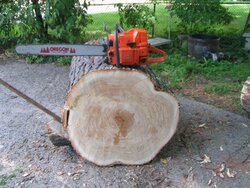
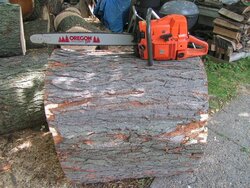
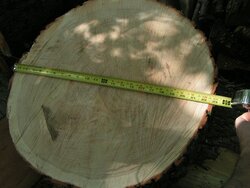
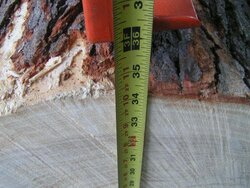
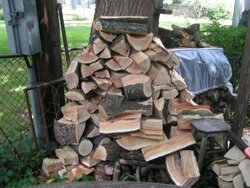

 or clean out their garage/basement cause they're too damn cheap & ignorant to PAY someone.
or clean out their garage/basement cause they're too damn cheap & ignorant to PAY someone.